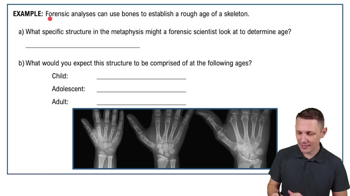Here are the essential concepts you must grasp in order to answer the question correctly.
Bone Structure
Bone is composed of a dense matrix that includes concentric layers called lamellae, which surround a central cavity known as the Haversian canal. This structure is crucial for understanding how bones are organized and how they function in supporting the body and facilitating movement.
Recommended video:
Gross Anatomy of Bones - Structure of a Long Bone Example 1
Diaphysis vs. Epiphyseal Plate
The diaphysis is the long, tubular shaft of a long bone, primarily composed of compact bone, while the epiphyseal plate, or growth plate, is a hyaline cartilage structure found at the ends of long bones. The presence of concentric layers suggests that the slide is likely from the diaphysis, as the epiphyseal plate does not exhibit this layered structure.
Recommended video:
Passive vs. Active Transport
Microscopic Anatomy of Bone
The microscopic anatomy of bone includes various structures such as osteons, which are the functional units of compact bone. Each osteon consists of concentric lamellae surrounding a central canal, which is essential for nutrient and waste exchange. Recognizing these features helps in identifying the specific type of bone tissue being observed.
Recommended video:
Microscopic Anatomy of Bones - Bone Cells Example 1
 Verified step by step guidance
Verified step by step guidance


